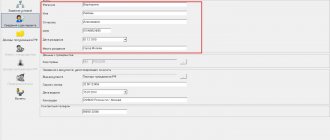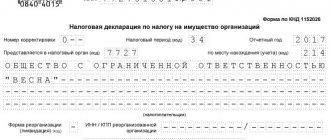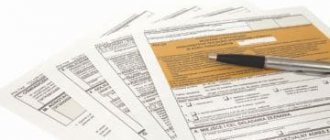Hello! Today we’ll talk about filling out a tax return under the Unified Agricultural Tax and give examples.
Unified Agricultural Tax is a taxation system that individual entrepreneurs and legal entities that are agricultural producers can switch to. Today we will figure out how to report under the Unified Agricultural Tax, or rather, how to fill out a declaration yourself. So, let's talk about everything in order.
Unified agricultural tax: what kind of taxation system is it?
The unified agricultural tax is a system that involves its use by business entities subject to compliance with the criteria established by law. The tax itself replaces the income tax for organizations for companies and personal income tax for entrepreneurs.
In 2021, entities using this system are also exempt from VAT. However, starting in 2021, this rule is changing - payers will be required to determine and pay VAT, and will also be able to deduct input tax.
The Tax Code establishes that it will be possible to obtain tax exemption, but for this, income will have to fall within the established limit.
For 2021 it is set at 100 million rubles, for 2021 - 90 million rubles and then in descending order. Attention: starting from 2021, entities using the Unified Agricultural Tax system must pay property tax.
Property that is used directly in the production of agricultural products will not be included in the base. In connection with the introduction of sanctions and a significant increase in agricultural production, a further increase in the tax burden on this system is possible.
This system can only be used by those entities that carry out primary processing of their own agricultural products, and is not available to those involved in secondary processing. The transition to agricultural tax is voluntary.
Attention: when using Unified Agricultural Tax, a business entity has the right to use UTII for other types of activities. However, it is imperative to control the share of revenue from core activities.
Using this system, it is possible to obtain benefits for paying social contributions on the earnings of registered employees from companies and entrepreneurs.
Who reports
All categories of single agricultural tax payers are required to submit a reporting declaration to the Federal Tax Service. These include commodity producers of agricultural products, not only organizations, but also individual entrepreneurs and entities that provide services in the field of crop and livestock production for agricultural producers.
Please note that in accordance with clause 2.1 of Art. 346.2 of the Tax Code of the Russian Federation, fishing organizations and merchants who fish aquatic biological resources are also recognized as payers of the Unified Agricultural Tax.
Firms that carry out only primary or secondary processing of agricultural products are not entitled to apply the Unified Agricultural Tax. Also, budgetary organizations, manufacturers of excisable goods and participants in the gambling business do not have the right to switch to agricultural tax.
Conditions for applying the Unified Agricultural Tax in 2018
To use the Unified Agricultural Tax in 2021, several criteria have been defined that all organizations and entrepreneurs must meet:
- Activities take place in animal husbandry, crop production, fisheries;
- All entities using the system must be engaged in the production of agricultural products, and not just their processing. The share of income from production must be at least 70% of the total size;
- The subject is engaged in fishing, belongs to the city-forming enterprises, the number of registered employees does not exceed 300 people. Also, the vessels that are used in this activity can be either their own or hired under a charter agreement. The share of basic income must also be above 70% of the total.
- The business entity provides services for field preparation, sowing and harvesting, grazing and moving livestock, etc. For the main revenue, it must be more than 70% of the total revenue.
- The entity is an agricultural cooperative that sells its own agricultural products. The share of revenue from core activities must exceed 70% of the total amount.
Important: agricultural tax cannot be used by those who produce excisable products, organize gambling, or are state-owned, autonomous or budgetary institutions.
Unified agricultural tax rate and its calculation
To correctly calculate tax, income and expenses should be taken into account in a special book (order of the Ministry of Finance of the Russian Federation dated December 11, 2006 No. 169n). At the same time, its official administration by the Tax Code of the Russian Federation is provided only for individual entrepreneurs (clause 8 of Article 346.5 of the Tax Code of the Russian Federation). Companies themselves must develop a register with the help of which they will record business transactions.
For information on the rules by which this book is filled out, read the article “Rules for maintaining a book of income and expenses under the Unified Agricultural Tax.”
All funds received into the current account are classified as income (Articles 249, 250 of the Tax Code of the Russian Federation). The costs specified in paragraph 2 of Art. 346.5 of the Tax Code of the Russian Federation are included in expenses. These include those costs whose feasibility has been confirmed. These include expenses for:
- purchasing and upgrading the OS;
- acquisition of intangible assets;
- property rental;
- purchase of seed material;
- OS, property, crop insurance;
- business trips;
- services of notaries, lawyers, auditors;
- communication services;
- training of personnel of new productions;
- purchase of young livestock, poultry and fish fry;
- other types of expenses.
All listed expenses are subject to accounting if they coincide with the criteria of Art. 252, 254, 255, 263–265, 269 Tax Code of the Russian Federation.
The tax itself is determined by multiplying the difference between income and expenses by a rate of 6%. The rate may be reduced for Crimea and Sevastopol to 4% in 2017–2021.
The procedure for transition to a single agricultural tax
There are several ways to start using this system:
- From January 1 of the new year. In this case, the notification must be sent before December 31 of the year preceding the year of intended use of this system;
- By submitting an application to switch to the system when registering a new business entity.
If at the time of registration of the subject the tax system was not selected, then the transition can be made within thirty days from the date of receipt of registration documents. Moreover, the day on which the business entity was registered will be considered the day when the use of the agricultural regime began. It is indicated in the extract from the unified register of the Unified State Register of Legal Entities or the Unified State Register of Legal Entities.
The application for transfer must be submitted for companies - at their location, and for entrepreneurs - at their registration address.
Business entities make the decision to use the Unified Agricultural Tax regime independently. To do this, they need to compare the pros and cons of all other tax systems.
If the Unified Agricultural Tax is applied through a transition from a different tax system, then the application must indicate the share of proceeds from the sale of agricultural products in total revenues. This indicator is determined based on data from the previous year of work.
Attention: before starting to use the unified agricultural tax, a business entity must notify the tax authority about this. If this is not done, then the right to use this system will not be established, and the tax authority will consider that the company or individual entrepreneur is on the previous system.
When switching to the Unified Agricultural Tax, it must be applied before the end of the current year. It is prohibited to refuse to apply it if all criteria meet those established by law.
Section 3
Section 3 should only be completed if the organization received additional funding (other than subsidies to autonomous institutions). Types of additional financing are listed in paragraphs 1 and 2 of Article 251 of the Tax Code of the Russian Federation.
In the section, reflect the data of the previous year on funds received but unused, the use period of which has not expired.
Please provide the following information:
- in column 1 – code of the type of funds received. The codes are given in Appendix 5 to the Procedure approved by order of the Federal Tax Service of Russia dated July 28, 2014 No. ММВ-7-3/384;
- in columns 2 and 5 - respectively, the date of receipt of funds or property and the period of their use established by the transferring party. If the period for using funds or property received as part of targeted financing has not been established, columns 2 and 5 do not need to be filled out (letter of the Federal Tax Service of Russia dated January 20, 2015 No. GD-4-3/2700);
- in columns 3 and 6 - respectively, the amount of funds received in previous tax periods, the period of use of which has not expired, and the amount of unused funds received in previous periods and not having a period of use.
In column 7, reflect funds used for purposes other than their intended purpose. Such funds must be included in non-operating income at the moment when the conditions for their receipt were violated (for example, the period for using the funds has expired).
Reflect fixed assets, intangible assets and other property in the report at market value.
This follows from Section VII of the Procedure, approved by order of the Federal Tax Service of Russia dated July 28, 2014 No. ММВ-7-3/384.
An example of filling out a declaration under the Unified Agricultural Tax
Alpha LLC is engaged in growing vegetables and uses Unified Agricultural Tax.
In 2015, the organization received taxable income in the amount of RUB 5,000,000. The amount of expenses incurred is RUB 3,500,000.
Alpha has a loss incurred in past periods - 115,000 rubles. During the reporting year, Alpha’s accountant took into account the loss incurred in previous years in the amount of 10,000 rubles. The remaining amount of the loss will be taken into account in subsequent years.
Also in 2015, Alpha received a grant from the state in the amount of 200,000 rubles, but has not yet used it. The accountant reflected the amount of the grant in section 3 of the declaration.
On March 25, 2021, an Alpha accountant submitted a declaration under the Unified Agricultural Tax for 2015 to the inspectorate.
Calculation of the unified agricultural tax
In order to calculate the amount of tax, it is necessary to use the base in the form of the amount of income received, which is reduced by the amount of expenses incurred in the same period. The exact list of expenses is determined in the Tax Code, and currently includes more than 40 items.
For the Unified Agricultural Tax, the rate is currently set at 6%. In Crimea and Sevastopol, the 4% rate continues to apply in 2021. From 2021, municipal authorities can set a differentiated tax rate from 0% to 6%, based on the category of payers.
In order to calculate tax amounts, a business entity must keep accounting records. Moreover, both companies and entrepreneurs should do this.
The value of income and expenses during the year must be recorded on an accrual basis.
Let's look at tax calculation as an example.
Kuritsa LLC uses an agricultural tax system and applies a rate of 6%. In the period from January 2021 to July 2021, it received income in the amount of RUB 10,800,000. At the same time, the company confirmed expenses in the amount of RUB 5,450,000. At the end of six months, the accountant needs to calculate the down payment.
The payment amount is (10,800,000-5,450,000)x6%=321,000 rubles.
This payment must be made by July 25, 2021.
After this, between July and December 2021, Kuritsa LLC received income in the amount of 8,320,000 rubles, and at the same time incurred expenses of 6,890,000 rubles.
Since the calculation must be made on an accrual basis, then:
(10800000+8320000)-(5450000+6890000)x6%=406800 rub.
Since an advance payment was made for the first six months, the following amount must be paid:
406800-321000=85800 rub.
This tax is transferred until March 31 of the year following the year of calculation. The same deadline is set for sending a tax return.
Purpose
The Unified Agricultural Tax return is intended, first of all, to notify the tax authority about the functioning of the business turnover system. From the declaration you can obtain information about income received in the reporting period, about expenses incurred for the purchase of raw materials and materials, about the tax base, rate and current benefits.
Of course, according to information from the declaration, the agricultural producer pays tax to the budget.
The declaration helps tax authorities more effectively monitor the activities of producers and distributors of agricultural goods. Failure to submit a tax return on time may arouse suspicion on the part of regulatory authorities, so you should not delay filing it.
Reporting
The use of the regime with payment of the Unified Agricultural Tax implies the obligation for its payer to submit a declaration annually on time, as well as at a certain time to make calculations and transfer tax payments to the budget.
This responsibility rests with the head of the company, accountant or other representative acting on the basis of a executed power of attorney.
The Unified Agricultural Tax declaration can be submitted personally to the inspector, sent by mail, or through the document management system.
The tax return for the unified agricultural tax must be submitted once, after the end of the calendar year, until March 31 of the following year after the reporting year.
However, if the regime was not used for any reason by a business entity for the entire reporting period, then it must be sent to the tax office before the 25th of the next month, after the end of the application of the Unified Agricultural Tax.
The tax base for this tax is formed by the totality of accounting for income received and expenses incurred for this type of activity. To record these indicators, a tax register is used - a book of income and expenses.
It must be sewn and numbered. All facts of income receipt and expenses must be reflected by recording them in chronological order. The basis for creating a record is the primary document.
Attention: if errors are made, they can be corrected by making appropriate adjustments with a correction note and the performer’s visa.
If a company seal is used, the correction must be certified by it. An erroneous mark must be carefully crossed out with one line so that it can be read.
The procedure for maintaining KUDiR
The income-expenditure accounting book is regulated by Appendix No. 2 of the PMF No. 169–2006. The form is unified. It has been updated several times, so be sure to get the latest forms. It is permissible to make changes to the book to more fully reflect the specifics of the enterprise's activities. Keeping a book is mandatory for firms and companies for all types of taxation, except for UTII.
Do I need to keep records for an individual entrepreneur?
Individual entrepreneurs conduct KUDiR on a patent, rather, for tax statistics. Accounting has no practical significance for an entrepreneur on PSN. Since the entire amount of tax on a patent is paid in advance. According to the “Pay and Work” principle. Nevertheless, tax authorities may require from individual entrepreneurs for patent tax not only payment orders for the payment of the Unified Agricultural Tax, but also KUDiR.
Full instructions for maintaining KUDiR here.
Instructions for maintaining KUDiR for accountants
The procedure for maintaining the book is quite voluminous; it contains 5–6 pages of typewritten text. The basic rules are as follows:
- Since 2015, KUDiR has not been registered with the territorial tax authorities. Provided only upon request, in case of desk inspection, etc.;
- maintaining KUDiR on the Unified Agricultural Tax is mandatory. The book can be in paper or electronic form;
- The paper version contains a title page and working pages. The sheets are numbered. The book is bound and sealed with the seal or signature of the director;
- before presenting the KUDiR to the tax authorities, the electronic version is printed and executed like a regular paper version;
- For each reporting period, a new KUDiR is established. Books from past years are kept for at least five years;
- corrections are not applied in the book. Amendments are made by a new entry and certified by the signature of the responsible person on the sheet with the adjustment;
- Income and expenses are maintained in an incremental manner from the beginning to the end of the reporting period.
Tax payment
The legislation stipulates that this tax must be transferred to the budget twice a year. The first time this must be done based on the results of work for the first half of the reporting year no later than July 25. This is considered an advance payment.
The second time payment must be made based on the results of work for the year. In this case, the tax is calculated in full, and then it is reduced by the previously paid advance amount. The subject must send the received amount to the budget before March 31 of the next year.
Design rules
Fill out the declaration form taking into account the standard rules for preparing fiscal reporting. Let us recall the main recommendations:
- Double-sided printing and binding pages together is prohibited;
- corrections are unacceptable, corrector cannot be used;
- text values are entered in capital block letters;
- if there is no data, put a dash;
- filling out fields and lines starts from the first left cell;
- numerical indicators are indicated in full rubles, taking into account rounding.
IMPORTANT!
Information on accrued and paid amounts of fines and penalties under the Unified Agricultural Tax is not reflected in the declaration. These amounts do not apply to tax calculations.
Loss of the right to apply tax
All situations where economic entities, be they legal entities or entrepreneurs, lose the ability to apply the Unified Agricultural Tax are enshrined in regulations.
These include:
- Failure to comply with the type of activity for which the Unified Agricultural Tax system is used, that is, the production, processing and sale of agricultural products is not carried out.
- In addition to the activities of creating, processing and selling agricultural products, the company is engaged in the production of excisable goods or the gambling business.
- Violation of the share of income attributable to the creation, processing and sale of agricultural products. The right is lost if the share of this income falls below 70%.
- The number of people employed under employment contracts in fishing farms and entrepreneurs exceeds 300 people. This restriction does not apply to agricultural producers.
Attention: as soon as one of the above cases occurs, an organization or company must report this to the tax office independently using a special form “Notification of loss of the right to unified agricultural tax”, for which form 26.1-2 is provided. There is a deadline of 15 days for submitting this document.
At the same time, an economic entity will be able to return to this regime after a year has passed since it lost this right. The loss of the right to use the Unified Agricultural Tax leads to the fact that from the beginning of the year it is necessary to recalculate all taxes according to OSNO in the new regime - income tax (personal income tax for individual entrepreneurs), VAT and pay them independently.
Tax return of the Unified Agricultural Tax
Home / Tax returns
| Table of contents: 1. Dates and place of submission of the declaration 2. Submission methods and form structure 3. Instructions for filling out the declaration | 4. Zero reporting under Unified Agricultural Tax 5. Fines for failure to submit a declaration 6. Programs for preparing a report |
The Unified Agricultural Tax declaration is a mandatory type of annual reporting submitted to the Federal Tax Service by organizations and entrepreneurs (including peasant farms) that are agricultural producers and pay a single tax in connection with the application of the Unified Agricultural Tax.
The KND declaration form 1151059 was approved by Federal Tax Service order No. ММВ-7-3/ [email protected] (as amended by Federal Tax Service order No. ММВ-7-3/ [email protected] ).
Download the Unified Agricultural Tax declaration form
View a sample of filling out a declaration: for an individual entrepreneur or for an LLC
Deadlines and place for submitting the declaration
The declaration should be submitted to the tax authority:
- at the place of residence of the individual entrepreneur;
- at the place of registration of the organization (legal entity).
The tax period under the Unified Agricultural Tax is a calendar year.
The declaration is submitted annually no later than March 31 of the year following the expired tax period.
If the tax filing deadline falls on a weekend, the last day to submit the return is the next business day.
Thus, to submit a report on the Unified Agricultural Tax:
- for 2021 should be no later than April 2, 2021 ;
- for 2021 - no later than April 1, 2021 .
If the taxpayer has lost the right to use the Unified Agricultural Tax during the tax period, then the declaration must be submitted no later than the 25th day of the month following the month in which the subject lost the status of an agricultural producer.
The date of submission of the report on the Unified Agricultural Tax is recognized as:
- when submitting to the tax authorities in person or through an authorized person - date of submission;
- when sent through a post office - the date on the postal receipt;
- when transmitted through an electronic document management operator - the date of dispatch confirmed by the operator.
Methods for submitting reports under the Unified Agricultural Tax
You can submit a declaration in the following ways:
1) In paper form in person, through an authorized person (with the obligatory presentation of a power of attorney: notarized - for a representative of an individual entrepreneur, simple - for a person representing the interests of a legal entity) or through Russian Post (by a valuable letter with a list of attachments).
Tax reporting on paper is submitted:
- in 2 copies. – when submitting to the Federal Tax Service;
- in 1 copy. – when sent by mail.
Depending on the requirements of the local inspectorate, it may be necessary to duplicate the submitted reports as an XML file on a flash drive.
2) In electronic form through EDF operators or an Internet service located on the Federal Tax Service website.
If the total number of personnel of an economic entity exceeds 100 people, tax reporting is submitted only in electronic form.
Declaration structure
The report on the Unified Agricultural Tax includes:
- title page;
- section 1, which indicates the amount of the single agricultural tax to be transferred to the budget for the tax period;
- section 2, in which the taxpayer provides the tax calculation;
- section 2.1, containing the amounts of loss by which the tax base under the Unified Agricultural Tax is reduced;
- Section 3, reflecting information about targeted receipts of funds, services (work), property and information about their use.
Instructions for filling out the Unified Agricultural Tax declaration
The procedure for filling out the declaration (hereinafter referred to as the Procedure) is contained in Appendix No. 3 to the Federal Tax Service order No. MMV-7-3 dated July 28, 2014 / [email protected]
General requirements
1. The report is filled out manually using purple (black, blue) ink or printed on a printer.
2. When preparing a declaration, it is not allowed:
- fasten sheets with metal staples;
- correct errors using a proofreader;
- use double-sided printing of sheets on the printer.
3. Amounts reflected in the report are subject to rounding to full rubles in accordance with the mathematical rules of rounding.
4. Pages are numbered in continuous order, regardless of the composition of the declaration, in the format: “001”, “002”, etc.
5. For each individual field of the declaration, a certain number of cells is provided, and one field is intended for entering only one indicator.
6. All report fields are filled in starting from the first left cell.
When using the software, numerical values are aligned to the rightmost familiarity.
7. Text fields of the report are filled in capital letters; when preparing a report using a computer, Courier New font is used (size 16 - 18 points).
8. In the absence of any indicator, dashes are placed in empty cells, while if the document is prepared using software, it is allowed that there is no framing of cells and dashes in empty fields.
9. If, when specifying any indicator, filling out the entire field is not required, dashes are placed in the cells that remain empty (for example: the organization’s TIN is indicated as follows: “2346783495–”).
10. A declaration prepared on paper can be printed as a machine-readable form containing a two-dimensional bar code.
Title page
1. The title is filled in by the business entity, with the exception of the block “To be filled out by an inspectorate employee.”
2. INN/KPP. The corresponding codes are indicated. Entrepreneurs do not fill out the checkpoint code field.
3. Correction number. If the report is submitted for the first time, the code is filled in: “0–”. An updated declaration is submitted if the data submitted earlier changes. In this case, the serial number of the updated calculation is indicated: “1–”, “2–”, etc.
4. Taxable period. The tax period code is indicated:
| Code | Period |
| 34 | Year |
| Last tax period: | |
| 50 | upon liquidation (reorganization) of a legal entity when closing an individual enterprise |
| 95 | when switching to another tax regime |
| 96 | upon termination of business activity upon closure of activities at the Unified Agricultural Tax |
5. Reporting year. The year for which information is being provided is indicated.
6. Tax authority code. Fill in the four-digit code of the Federal Tax Service to which the report is submitted. The first two digits of this code are the region number, the next two digits are the number of the inspection itself.
7. Code at the place of registration. The code for the place of presentation of the document is indicated:
| Code | Name |
| 120 | At the place of residence of the individual entrepreneur |
| 213 | At the place of registration of the largest taxpayer |
| By location: | |
| 214 | a Russian organization that is not one of the largest taxpayers |
| 215 | successor of the Russian company |
| 216 | successor belonging to the largest taxpayers |
| 331 | At the place of business of the foreign company |
8. Next, indicate the full name of the legal entity in accordance with the constituent documents or full name of the individual entrepreneur (line by line).
9. OKVED code. The type of activity code is entered according to the all-Russian classifier OKVED2.
10. Reorganization (liquidation) code and TIN/KPP of the reorganized legal entity. Indicated only during liquidation (reorganization) of the company. In these cases, fill in the code from Appendix No. 2 to the Procedure:
| Code | Name |
| 1 | Conversion |
| 2 | Merger |
| 3 | Separation |
| 5 | Accession |
| 6 | Division with simultaneous accession |
| 0 | Liquidation |
11. Next, write down the taxpayer's contact phone number.
12. The corresponding fields indicate the number of sheets of the report and attached documents. If there are no attachments to the declaration, dashes are placed in the empty spaces.
13. Power of attorney and completeness of information. The first cell of this block contains the code:
- 1 – if the taxpayer submits the declaration;
- 2 – if the document is submitted by an authorized person.
The remaining fields of the block are filled in as follows:
| Who submits the declaration | What information should be provided? |
| IP | puts only the signature and date of signing the document |
| Organization | filled in with full name. manager, dated and signed |
| Representative – individual | Full name is entered. representative, a date and signature are given, then the details of the document confirming the authority of the person are indicated |
| Representative – legal entity | Full name is indicated. authorized individual of the representative company, then fill in the name of the representative company, put the signature, date and details of the document confirming the authority of the person who signed the declaration |
Section 1
1. On lines 001 and 003, fill in the OKTMO code at the place of residence of the entrepreneur (place of registration of the organization).
In this case, line 001 must be filled in, and the code in line 003 is entered only when the individual entrepreneur’s place of residence (location of the legal entity) changes.
If the business entity has not changed its place of registration with the Federal Tax Service, dashes are placed in line 003.
2. Line 002 reflects the amount of the advance payment under the unified agricultural tax accrued for payment for the reporting period (the first half of the year).
3. On line 004 you need to indicate the amount of tax that should be paid additionally to the budget based on the results of the year, taking into account the advance payment made earlier. This line is filled in if the following relationship is true:
Line 050 of section 2 – line 002 ≥ 0,
i.e. if the amount of tax calculated at the end of the year is greater than the amount of the advance payment made or equal to this amount.
If the above inequality does not hold, line 005 should be filled in.
Note: according to the letter of the Federal Tax Service dated June 29, 2017 No. SD-4-3/ [email protected] , before changes are made to the current Unified Agricultural Tax declaration form, entrepreneurs using Unified Agricultural Tax + PSN and who have lost the right to PSN during the tax period, reduce the amount of tax by line 004 for the cost of the patent.
4. Line 005 reflects the amount of unified agricultural tax to be reduced for the tax period. Information is entered in this line if the following relationship is true:
Line 050 of section 2 – line 002 < 0,
i.e. if the Unified Agricultural Tax calculated at the end of the year turned out to be less than the advance payment paid for the six months.
This situation occurs if in the second half of the year the amount of expenses increased sharply and, therefore, the total expenses at the end of the tax period exceeded the income received.
Section 2
1. Line 010 records the amount of income received by the business entity for the calendar year, which is taken into account when calculating the tax base under the Unified Agricultural Tax, in accordance with clause 1 of Art. 346.5 Tax Code of the Russian Federation.
2. Line 020 reflects the amount of expenses incurred by the entity during the tax period, which are taken into account when calculating the base for the Unified Agricultural Tax in accordance with clauses 2 - 4.1., 5 of Art. 346.5 Tax Code of the Russian Federation.
3. Line 030 indicates the single tax base, which is the difference between lines 010 and 020. Moreover, if a loss is incurred in the tax period, i.e. expenses exceed income, the tax base is considered equal to 0.
4. On line 040, you should indicate the amount of loss received in previous tax periods from line 010 of section 2.1., which reduces the base for the Unified Agricultural Tax.
The loss can be offset partially or in whole, the main thing is that its size does not exceed the tax base on line 030. The unaccounted balance of the loss can be carried forward to the next year.
5. Line 045 records the rate of the single agricultural tax established by clause 1 of Art. 346.8 of the Tax Code of the Russian Federation or the authorities of the region where the business entity operates.
6. Line 050 indicates the amount of tax for the calendar year, calculated using the formula:
(Line 030 – line 040) * line 045 / 100.
Section 2.1
This section is filled out only by those business entities that received losses as a result of previous tax periods.
The taxpayer has the right to carry forward losses for 10 years following the loss year.
If costs exceeded income for several years in a row, then such losses are carried forward to future tax periods in the order in which they were received.
Example: an agricultural producer suffered losses for 2 years: in 2015, expenses exceeded income by 30,000 rubles, in 2021 the loss amounted to 50,000 rubles. The tax base for the Unified Agricultural Tax for 2021 amounted to 70,000 rubles.
Thus, the company can offset at the end of 2021: a loss of 2015 in the amount of 30,000 rubles. entirely, loss for 2021 partially - 40,000 rubles. Unaccounted balance of loss in the amount of RUB 10,000. will be rescheduled to 2021.
The section lines are filled in as follows:
| Line number | Content |
| 010 | The total loss is reflected (the sum of lines 020-110) received based on the results of previous years and not carried forward to the beginning of the past year |
| 020-110 | Fill in the amounts of losses broken down by year of their formation (equal to lines 140-230 of section 2.1 of the report for the previous tax period) |
| 120 | The loss for the past calendar year is indicated (the difference between lines 020 and 010 of section 2). This indicator is filled in only if line 010 < line 020 |
| 130 | The total loss is reflected at the beginning of the next calendar year, which can be offset in future periods. It is calculated as: line 010 – line 040 of section 2 + line 120. This indicator is transferred to line 010 of section 2.1 of the report for the next calendar year |
| 140-230 | Losses broken down by year that were not offset in the previous tax period are filled in. In this case, the loss received in the past year is indicated last. The sum of lines 140-230 is equal to the indicator reflected in line 130. The values of lines 140-230 are subject to transfer to section 2.1 of the reporting of the future period, where they are reflected in lines 020-110 |
Section 3
This section is completed by those taxpayers who received additional funding (with the exception of subsidies provided to autonomous institutions). Types of targeted financing are listed in clauses 1, 2 of Art. 251 Tax Code of the Russian Federation.
The section contains information about the expired tax period for funds received but not spent, the period of use of which has not yet expired, as well as for funds for which the period of use is not established.
The section columns are filled in in the following order:
| Column ordinal number | Content |
| 1 | The code for the type of income from Appendix No. 5 to the Procedure is indicated (in the form of property, cash, work, services) |
| 2 / 5 | The date of receipt of targeted funding and the period of its use, which is established by the transferring party, are filled in. If the period for using the funds is not set, these columns are not filled in |
| 3 / 6 | The amount of funds received in expired tax periods, the period of use of which has not yet expired, is indicated, as well as the amount of funds received in past periods for which the period of use was not initially established. Property is reflected in the declaration at market value |
| 4 / 7 | The amount of funds used on time for the intended purpose is indicated, as well as the amount of funds not used on time or spent for other purposes |
In the line: “Report total” the total values for columns 3, 4, 6, 7 are filled in.
Zero reporting under Unified Agricultural Tax
If a newly created organization or individual entrepreneur registered as payers of the unified agricultural tax did not conduct business activities in the first tax period and did not violate the requirements established for the use of this special regime, they have the right to continue using the Unified Agricultural Tax in the next calendar year (subparagraph 1 p. 4.1, Article 346.3 of the Tax Code of the Russian Federation).
In this case, based on the results of the first tax period, you should submit zero reports under the Unified Agricultural Tax.
The zero declaration includes:
- title page;
- section 1;
- section 2.
Penalties for failure to submit a declaration
If a business entity is late in submitting a declaration under the Unified Agricultural Tax, the fine will be from 5% to 30% of the amount of unpaid tax indicated in the reporting for each full or partial month of delay, but not less than 1,000 rubles.
Moreover, if the Unified Agricultural Tax is paid on time, then failure to submit the report on time will cost 1,000 rubles.
For violation of the reporting method, inspectors may impose a fine of 200 rubles.
Administrative liability for late reporting, imposed on the head of the organization, can range from 300 to 500 rubles.
For a delay in filing a tax return for more than 10 working days, the Federal Tax Service has the right to block the taxpayer’s current account.
Report preparation programs
The Unified Agricultural Tax declaration can be prepared using the following programs:
| Software name | Website |
| “Taxpayer Legal Entity” (free) | https://www.nalog.ru/rn77/program/5961229/ |
| "Bukhsoft" | https://online.buhsoft.ru/2017/reps/external.php?rep=23 |
| "Sky" | nebopro.ru |
| "My business" | www.moedelo.org |
| "Taxpayer PRO" | nalogypro.ru |
| "1C" | 1c.ru |
Read in more detail: Tax return under the Unified Agricultural Tax
Did you like the article? Share on social media networks:
- Related Posts
- Sample of filling out a UTII declaration for an LLC
- Sample of filling out the Unified Agricultural Tax declaration for individual entrepreneurs
- Tax return UTII
- Sample of filling out the UTII declaration for individual entrepreneurs
- Sample of filling out the Unified Agricultural Tax declaration for an LLC
- Tax return for simplified tax system in 2021
- Sample of filling out the simplified taxation system “income” declaration
- Explanatory note to the tax return for UTII
Leave a comment Cancel reply
Procedure for deregistration of unified agricultural tax
In order to deregister as a Unified Agricultural Tax payer, a business entity must inform the Federal Tax Service Inspectorate using a special form about its decision before January 15 of the following year. He can change this regime voluntarily only from the beginning of the year. In this case, you need to use the form provided by law “Notification of refusal to use the Unified Agricultural Tax” form 26.1-3.
Attention: if a company, for one reason or another, completes this activity, then it must also send a message to the Federal Tax Service. To notify the Federal Tax Service, there is a special form “Notification of termination of the activities of the Unified Agricultural Tax” form 26-1-7. The taxpayer must report this within 15 days.
Business entities send a notification of deregistration or refusal to use the unified agricultural tax to the Federal Tax Service at their location - for legal entities, at the place of registration - for individual entrepreneurs.
Tags: Unified Agricultural Tax Tax regimes
Legislation
The new Unified Agricultural Tax declaration was approved by the Order of the Tax Service, dated July 28, 2014 under number ММВ-7-3/ [email protected] (hereinafter referred to as the Order).
In addition to the document form itself, the Order also contains information on how to fill out each section, in what form the declaration can be submitted, as well as various useful Appendices (codes of tax periods, reorganization forms, places of submission, etc.).
Thus, from the above document the taxpayer can receive all the necessary advice on filling it out.
In addition to the Order, regulatory provisions on agricultural tax declarations are also contained in the Code, in particular, in Art. 346.10.
The article reads:
- where to file tax returns - at your place of residence or location;
- in what time frame?
Book of accounting of income and expenses of the Unified Agricultural Tax - whether it is necessary to keep it and how to fill it out
KUDiR eskhn
The Tax Inspectorate needs access to the client’s reporting - this way you can double-check the data reflected in the declaration and calculate the amount to be paid. Need to lead:
- for entrepreneurs - KUDiR;
- organizations - full-fledged accounting.
Submitting these documents to the inspectorate is not required - a tax return is sufficient. But reporting (as well as compliance with cash discipline and working with cash register systems) are defined by the Tax Code of the Russian Federation and are mandatory.
Filling out the KUDiR is not difficult. The book proceeds as follows:
- It is allowed to reflect transactions in paper form or in an online accounting system;
- a new volume is started every year;
- at the end of the period, the document is printed, stitched, numbered, and sealed;
- each operation is reflected on a separate line;
- all movements must be supported by documents;
- if an entrepreneur has several taxation regimes, KUDiR for Unified Agricultural Tax is maintained separately;
- unfilled sections, “zero” books, are drawn up in the general order.
Comparison of tax amounts in different systems
Unified agricultural tax is a regime for agricultural enterprises. Their main type of business (accounting for 70% of revenue) should be the production of agricultural products. The procedure for applying the Unified Agricultural Tax and calculating tax payments is regulated by Art. 346 NK .
The Code offers other regimes for agricultural enterprises. However, the tax in question is the most financially beneficial:
| Tax system | Tax rate | The tax base |
| BASIC (general) | 20% | Profit |
| simplified tax system (simplified) income | 6% | Income |
| simplified tax system income minus expenses | 5-15% (depending on region) | Income minus expenses |
| Unified agricultural tax (agricultural tax) | 6% | Income minus expenses |










